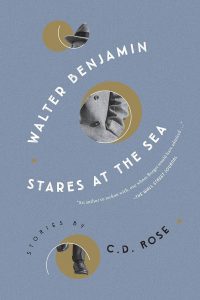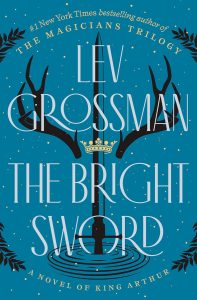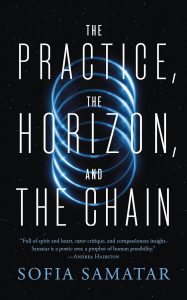The Year in Review 2024 by Ian Mond

After the slam dunk that was 2023, I had high hopes for 2024 – too high, as it turns out. 2023 was a rare vintage, the 1999 of films in book form (okay, maybe not that good). To expect that 2024 would scale those same heady heights was asking too much of the year, especially one already burdened by a world-shaping American election. Not that genre fiction schedules are influenced by an election year (at least not in the same way non-fiction is), but it would take a stupendous book to draw our attention away from the chaotic theatre that was the run-up to the election. How can any novel, no matter how good, compete with endless “they’re eating cats and dogs” memes on TikTok?
But in preparing for this column, I had a chance to reflect. 2024 may not have the standout vibes of 2023, but it was a very even, very consistent year. My best book for 2024 could have gone to any of five or six works. The year is so even that aside from the novella category (where I see a clear favourite – find out below), I couldn’t tell you which novels will be nominated for the major awards, let alone take home the trophy. This isn’t a bad thing. It allows for multiple voices to be heard, where it’s not the same two or three books being endlessly spoken about. On that note, here are the 20 or so voices I think you should be listening to.
 My favourite book of 2024 is (drumroll) Walter Benjamin Stares at the Sea by C.D. Rose. I read this collection way back in December 2023, and it has stuck with me ever since. Rose collects 19 playful, surreal and unexpected stories that often deal with people or objects that have vanished or been forgotten. The piece I most mention to sell the collection is “St. Augustine Checks His Twitter Feed”, which does what it says on the tin with the famed Bishop of Hippo hooked on the dopamine hit offered by the site formerly known as Twitter. There are so many other delights: a story told entirely in footnotes, a missing sister lost in time, and tales involving various historical figures, including Henri Bergson, Le Prince, and Hippolyte Bayard, to name three. The best piece is the extraordinary title story, which situates the German Jewish philosopher in an LA cinema, imagining his life as a private investigator. The story is even more poignant if you know how Benjamin’s life ended. I love this collection so much that I could easily knock out another thousand words about it.
My favourite book of 2024 is (drumroll) Walter Benjamin Stares at the Sea by C.D. Rose. I read this collection way back in December 2023, and it has stuck with me ever since. Rose collects 19 playful, surreal and unexpected stories that often deal with people or objects that have vanished or been forgotten. The piece I most mention to sell the collection is “St. Augustine Checks His Twitter Feed”, which does what it says on the tin with the famed Bishop of Hippo hooked on the dopamine hit offered by the site formerly known as Twitter. There are so many other delights: a story told entirely in footnotes, a missing sister lost in time, and tales involving various historical figures, including Henri Bergson, Le Prince, and Hippolyte Bayard, to name three. The best piece is the extraordinary title story, which situates the German Jewish philosopher in an LA cinema, imagining his life as a private investigator. The story is even more poignant if you know how Benjamin’s life ended. I love this collection so much that I could easily knock out another thousand words about it.
 My blockbuster for the year was Lev Grossman’s The Bright Sword. I’m not a massive fan of Arthuriana, but I inhaled the novel’s 700 pages in a blur of angels, green knights, wizards, witches, giants, fairies and elemental forces. Our hero is Collum, a resident of the island of Mull who wants to be a knight of the Round Table, only to discover he’s too late. Arthur is dead, and what remains of Camelot and the Round Table is in shambles. Even though I’m no expert, I enjoyed how Grossman reshapes the source material, throwing in anachronisms (as a nod to the malleable nature of the text) and presenting us with a diverse cast. Ultimately, The Bright Sword is about change, how no culture, however dominant, lives in a vacuum, how generations of intermingling have influenced our traditions and myths. It’s also a blast to read.
My blockbuster for the year was Lev Grossman’s The Bright Sword. I’m not a massive fan of Arthuriana, but I inhaled the novel’s 700 pages in a blur of angels, green knights, wizards, witches, giants, fairies and elemental forces. Our hero is Collum, a resident of the island of Mull who wants to be a knight of the Round Table, only to discover he’s too late. Arthur is dead, and what remains of Camelot and the Round Table is in shambles. Even though I’m no expert, I enjoyed how Grossman reshapes the source material, throwing in anachronisms (as a nod to the malleable nature of the text) and presenting us with a diverse cast. Ultimately, The Bright Sword is about change, how no culture, however dominant, lives in a vacuum, how generations of intermingling have influenced our traditions and myths. It’s also a blast to read.
Talking about a blast to read, City of Dancing Gargoyles by Tara Campbell is the book I’ve been recommending to people if they need a break from the shithole that is 2024 (and likely to be 2025). The mosaic novel takes place a century from now in a postapocalyptic West Coast of America irrevocably changed by the testing of alchemic weapons. With a depth and breadth of imagination and a wonderful sense of humour, we get to see how cities across the west coast have been transformed, whether it’s the “City with Gun-Toting Trees,” the “City of Fretting Books,” and the “City of Glaring Chocolates.” If that isn’t enough, framing these inventive vignettes is the story of four refugees, two humans (a mother and daughter) and two chatty gargoyles, all four seeking refuge. Storytelling this imaginative and vivid deserves your attention.
 Like City of Dancing Gargoyles, I found Lavanya Lakshminarayan’s Interstellar MegaChef immensely entertaining. Her follow-up to the Ten Percent Thief involves competition cooking, a queer love story, and cultural imperialism set against a far future backdrop where humanity (specifically those inhabiting the colony world of Primus) thinks they’re hot shit, the pinnacle of civilisation. I loved all the foods, the social commentary and, of course, the love/hate relationship between our two protagonists: Saraswati Kaveri, a respected Chef on Earth, rejected by the Primian tastemakers; and Serenity Ko, the abrasive and arrogant developer of a sim whose new idea will change cooking and culture forever. Interstellar MegaChef is just the starter. We get to return to this world in future novels in what I’m sure will be a sumptuous multicourse meal.
Like City of Dancing Gargoyles, I found Lavanya Lakshminarayan’s Interstellar MegaChef immensely entertaining. Her follow-up to the Ten Percent Thief involves competition cooking, a queer love story, and cultural imperialism set against a far future backdrop where humanity (specifically those inhabiting the colony world of Primus) thinks they’re hot shit, the pinnacle of civilisation. I loved all the foods, the social commentary and, of course, the love/hate relationship between our two protagonists: Saraswati Kaveri, a respected Chef on Earth, rejected by the Primian tastemakers; and Serenity Ko, the abrasive and arrogant developer of a sim whose new idea will change cooking and culture forever. Interstellar MegaChef is just the starter. We get to return to this world in future novels in what I’m sure will be a sumptuous multicourse meal.
Terrible food metaphors aside (sorry, Lavanya), Interstellar MegaChef is also a clever deconstruction of a utopian society. Adam Roberts’s Lake of Darkness takes a similar tack (but with much less cooking). Again, we are far into the future. Humanity is spread across the galaxy, living their best lives, entirely reliant on AI. Added to this mix, escaping a singularity, is the suave and decidedly slimy Mr Modo, also known as The Gentleman, who brings his devilish, evil wiles to a naïve universe. Like all of Robert’s work – including The Thing Itself and The This – the novel is fizzing with theoretical, metaphysical, and theological ideas with its fair share of jaw-dropping set pieces.
Regarding utopias, Laura van den Berg’s State of Paradise, which could easily have been my best book of the year, considers the notion of the perfect society from a dystopian perspective. Author van den Berg takes us to Florida in the near future, suffering with a postpandemic spiral including militias, violent crimes, thousands of feral cats, and significant weather events, all egged on by a Bible-preaching Governor who may or may not be Ron DeSantis. Our protagonist is a ghostwriter for someone who may or may not be James Patterson. Written in an epigrammatic style (think Jenny Offil) and steeped in oceans of irony, State of Paradise is a mordant satire about the weirdness of our current situation.
Florida plays a central role in a novel I never expected to read: Absolution, Jeff VanderMeer’s prequel to the Southern Reach trilogy published a decade ago. Since the novel’s release, all the talk has centred on the third section of the book, told from Lowry’s point of view (you’ll recognise his name if you’ve read the trilogy) and the number of “fucks” he uses (at times it feels like every second or third word). But that focus ignores the uncanny, mysterious beauty of the first two thirds of the book, a mix of Thomas Ligotti and John le Carré. I’d be pretty happy if VanderMeer returned to Area X (though he doesn’t need to wait a decade).
We move from Florida to the mountains of West Virginia, the setting for Kay Chronister’s The Bog Wife. As an example of Appalachian Gothic, the novel has all the ingredients: an inbred family, a ramshackle house perched on top of a cranberry bog, and an ancient ritual involving the birth of a “bog wife.” But Chronister takes these familiar tropes and undercuts them, presenting us with something unpredictable and exciting. A key element is that Chronister treats her characters, the Haddesley siblings, whose lives have been decided by their ancestors, with tenderness, giving them the agency to determine their destiny.
Although significantly different in tone and structure, Marie-Helene Bertino’s Beautyland, like The Bog Wife, is a novel that’s similarly empathetic toward its main character, Adina Giorno. Born on the same day as the launch of Voyager 1, Adina, at the age of four, realises that she’s an alien probe sent to investigate humanity, communicating with her masters via fax machine. While there’s ambiguity surrounding whether Adina is a literal alien, it’s not a question that Bertino is interested in addressing. Instead, this novel is about loneliness, about never entirely being in tune with those around you, told with incredible compassion and humour, tinged with sadness.
As is my wont, I gravitated to experimental novels, the sort of narratives that play with the conventional rules of fiction. Remember You Will Die by Eden Robin uses the obituary to tell a story about Peregrine, an AI ported into a sculpted human-shaped body looking for traces of Poppy, her dead human daughter (who jumped in a river and never resurfaced). What I adored about this novel is its word-associational quality, how the obituaries take us down a warren of branching tunnels, cul-de-sacs and tangents, covering issues such as motherhood, time travel, Jewish mysticism and outsider art.
 Vajra Chandrasekera’s Rakesfall is also bold and unconventional, but for very different reasons. On the heels of his award-winning debut, The Saint of Bright Doors, comes Vajra Chandrasekra’s Rakesfall, a highly experimental nonlinear story that centres on two entwined souls, Annelid and Leveret, who are reincarnated hundreds of thousands of times across the multiverse. It’s a ferocious, passionate novel, stitched together with stories and fables, about identity – the blurred lines between body, mind and self – and the legacy of colonialism (particularly in relation to the Sri Lankan Civil War).
Vajra Chandrasekera’s Rakesfall is also bold and unconventional, but for very different reasons. On the heels of his award-winning debut, The Saint of Bright Doors, comes Vajra Chandrasekra’s Rakesfall, a highly experimental nonlinear story that centres on two entwined souls, Annelid and Leveret, who are reincarnated hundreds of thousands of times across the multiverse. It’s a ferocious, passionate novel, stitched together with stories and fables, about identity – the blurred lines between body, mind and self – and the legacy of colonialism (particularly in relation to the Sri Lankan Civil War).
On the surface, Jesse Ball’s The Repeat Room looks like another “literary” dystopian novel, depicting an Orwellian-like society where everyone’s worth depends on their designation. The one splash of originality is the society’s system of jurisprudence, where a single juror judges the alleged criminal by experiencing the crime through the criminal’s eyes. Then comes the second half of the novel, and we, like our protagonist, who has been chosen as the juror, experience the crime – and, well, disturbing doesn’t adequately explain what we witness. When taken as a whole, The Repeat Room asks us, with a sharpness that belies the understated prose, to rethink our view of justice and the worth of a single life.
Private Rites, Julia Armfield’s second novel, and Three Eight One by Aliya Whiteley don’t have anything obvious in common, but under the hood, they are destabilising works of fiction. In the case of the former, we follow three bickering sisters – Isla, Irene, and Agnes – whose already-fraught relationship is worsened by the death of their father, an “architect as cruel as he was revered.” This all happens against the backdrop of a Ballardian drowned world – it never stops raining – with much of the action occurring in the siblings’ impractical home, made of glass and built on stilts. Then, in the last thirty pages, Private Rites takes a massive, ambitious swerve that undercuts an already unstable, tense narrative.
In contrast, the tale at the core of Three Eight One is confounding. A 24th-century archivist discovers a novel-length story published on the net in 2024, which tells the bewildering tale of Fairly, a member of a walled community that sends their youth out into the world to walk the mysterious Horned Road. Fairly’s narrative, which regularly switches from first person to second person to third person, is broken into bite-sized chunks, each consisting of 381 words. It’s an opaque experience for the reader and the characters, including the archivist, Rowena, who tries to clarify the text with over eighty footnotes. But that instability makes Three Eight One such an exciting, refreshing, fascinating read.
It wouldn’t be an end-of-year column if it didn’t feature A.G. Slatter’s latest Sourdough novel. Briar Book of the Dead re-introduces us to a coven of witches, the Briars (first encountered in the novella Of Sorrow and Such), who govern the town of Silverton, acting as a barrier against the Leech Lords in the north. Our narrator is Ellie, the new steward of Silverton, who doesn’t have a magical bone in her body – that is, until she hits her head at a funeral for the Briar matriarchs and starts to see and speak to ghosts; an odd state of affairs, given ghosts were banished from Silverton three centuries prior. As with the other tales and novels set in this Universe, storytelling and how it informs a culture and community are pivotal to the plot. I keep saying that Slatter is one of our best contemporary fantasists, so you won’t be surprised (especially if you read my column this month) when her latest novel, The Crimson Road, features in my wrap-up of 2025.
After a six-year break, Slatter’s fellow Australian Kaaron Warren returns with her best novel to date, The Underhistory. The year is 1941, and 10-year-old Temperance “Pera” Sinclair watches a plane crash into her house, wiping out her family but also the Australian Prime Minister (this event never happened – it’s a neat speculative wrinkle to what’s ostensibly a nonsupernatural horror novel). Fifty-two years later, Pera has spent most of her inheritance rebuilding the family home and running guided tours through the haunted house. While the ghosts in the house are all of Pera’s making, it has the texture and shape of a haunted house novel, with the narrative structured around each room. The introduction of five escaped prisoners, who believe Pera is hiding a fortune in the house, injects a shocking level of tension and violence. This is literary horror with a razor-sharp bite.
For something completely different, this year saw me review my first book of poetry for Locus. Here in the (Middle) of Nowhere by Anastacia-Reneé is a fusion of poetry and flash fiction that revolves around multiple women of colour, all named Lucille: The Gods of towns, villages, and Universes (of which there are several populated by vampires, zombies, and saints). If it wasn’t always clear what was going on, that didn’t matter, because I was taken in by the imagery, the beat, and a wicked sense of humour.
Other than Walter Benjamin Stares at the Sea, I read two other strong collections. My thoughts about Lucius Shepard’s Crows and Silences can be found in this month’s column, so I won’t repeat them here. I also enjoyed the 11 stories in Mouth, Puloma Ghosh’s debut collection. Whether they involve ice-skating vampires, temporal wars, or a town in lockdown terrorised by wolves, each piece is a skewed reflection of our world, with lyrical language and a keen understanding of loss, isolation, and desire.
 I don’t read many novellas (something I should rectify), but those I did get around to were excellent. Matthew Cheney’s Changes in the Land starts as an evocation of the spirit of M.R. James and Lovecraft only to transition into something far more interesting and nuanced – a story about American colonialism, of land stolen and Indigenous lives lost. It’s also a tender portrait of a lonely man – a subject Cheney returns to in his shorter fiction. I’m sure I won’t be the only person to call out Sofia Samatar’s terrific The Practice, the Horizon, and the Chain, a novella that’s a monty to be nominated for all the awards. It’s a generation-ship story about academia, class stratification, and slave labour with a mystical bent. Samatar’s skill at portraying the transcendent is extraordinary. Finally, there’s the hard-to-classify but rather brilliant A Mourning Coat by Alex Jeffers. The story is a blend of secondary world, contemporary technology, Hollywood gossip, fashion trends, and localised Gods – some places (countries or islands) have them, others don’t. It’s also a queer love story and a delicate tale in which the narrator struggles to come to terms with the death of a famous father who could be aloof. How Jeffers can contain all this in the space of a novella is an act of narrative magic.
I don’t read many novellas (something I should rectify), but those I did get around to were excellent. Matthew Cheney’s Changes in the Land starts as an evocation of the spirit of M.R. James and Lovecraft only to transition into something far more interesting and nuanced – a story about American colonialism, of land stolen and Indigenous lives lost. It’s also a tender portrait of a lonely man – a subject Cheney returns to in his shorter fiction. I’m sure I won’t be the only person to call out Sofia Samatar’s terrific The Practice, the Horizon, and the Chain, a novella that’s a monty to be nominated for all the awards. It’s a generation-ship story about academia, class stratification, and slave labour with a mystical bent. Samatar’s skill at portraying the transcendent is extraordinary. Finally, there’s the hard-to-classify but rather brilliant A Mourning Coat by Alex Jeffers. The story is a blend of secondary world, contemporary technology, Hollywood gossip, fashion trends, and localised Gods – some places (countries or islands) have them, others don’t. It’s also a queer love story and a delicate tale in which the narrator struggles to come to terms with the death of a famous father who could be aloof. How Jeffers can contain all this in the space of a novella is an act of narrative magic.
What better way to end my “Year in Review” than to recognise the work of critic extraordinaire Abigail Nussbaum and the publication of Track Changes: Selected Reviews. If anything, this was the most important and inspiring book I read this year because it deals with a topic I’m fully invested in: the art of criticism and writing meaningful, intelligent, and eclectic reviews. The 58 pieces featured in Track Changes are a masterclass on how to construct an argument, tease apart a work of art, place that work in its social and political context, and do it with wit and heart. Nussbaum is one of the best of us, a critic whose passion for the genre is infectious.
That’s a wrap on 2024. Onward to 2025.
Ian Mond loves to talk about books. For eight years he co-hosted a book podcast, The Writer and the Critic, with Kirstyn McDermott. Recently he has revived his blog, The Hysterical Hamster, and is again posting mostly vulgar reviews on an eclectic range of literary and genre novels. You can also follow Ian on Twitter (@Mondyboy) or contact him at mondyboy74@gmail.com.
This review and more like it in the February 2025 issue of Locus.
 While you are here, please take a moment to support Locus with a one-time or recurring donation. We rely on reader donations to keep the magazine and site going, and would like to keep the site paywall free, but WE NEED YOUR FINANCIAL SUPPORT to continue quality coverage of the science fiction and fantasy field.
While you are here, please take a moment to support Locus with a one-time or recurring donation. We rely on reader donations to keep the magazine and site going, and would like to keep the site paywall free, but WE NEED YOUR FINANCIAL SUPPORT to continue quality coverage of the science fiction and fantasy field.
©Locus Magazine. Copyrighted material may not be republished without permission of LSFF.






